Tillandsia schatzlii
Click thumbnails for full size, scaled to a new window.
Tillandsia schatzlii
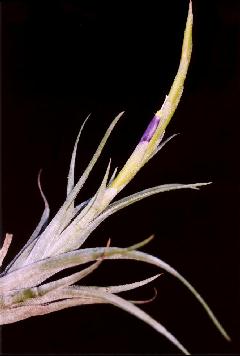
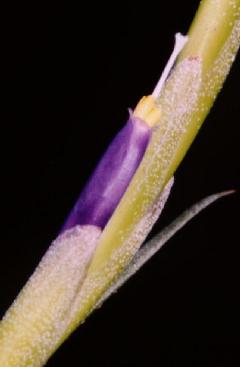
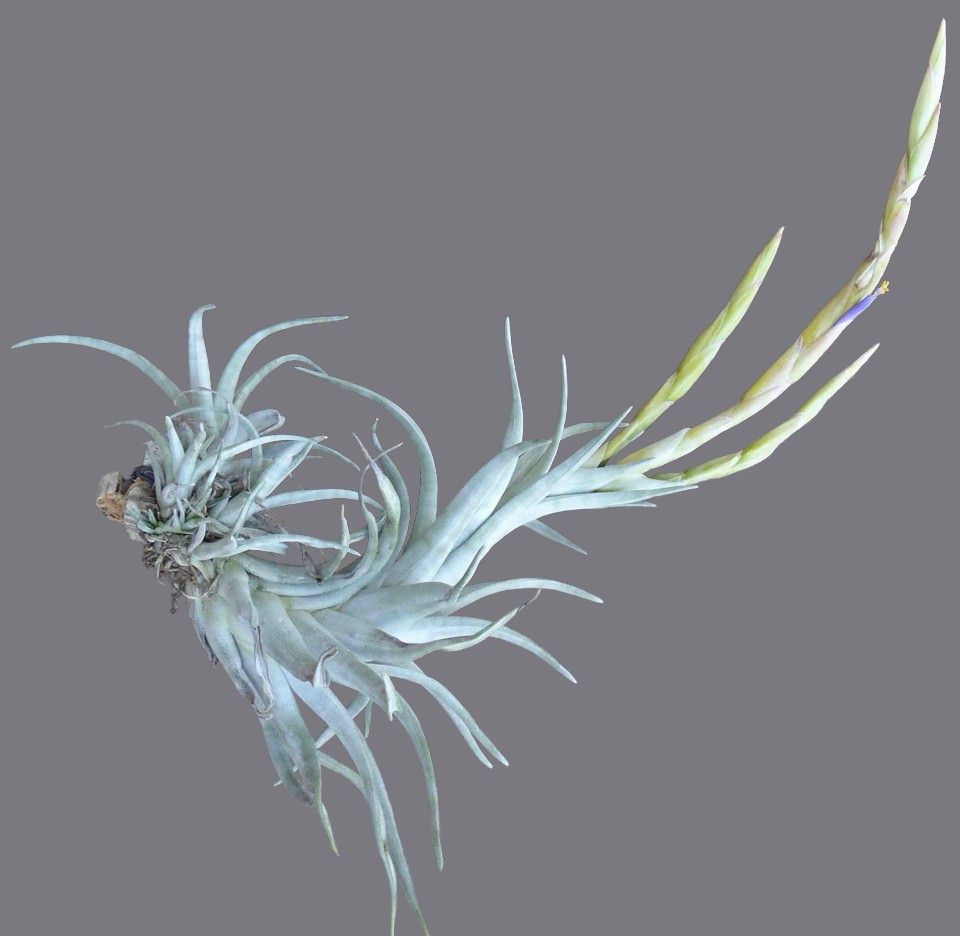
| Ken Woods 11/04 |
Bruce Dunstan 11/15 |
Bruce Dunstan ... "First flowering for me although after looking at the description I'm not so sure now. The simple pendent spike mentioned doesn't seem to be the case in this individual. Thoughts appreciated. Inflorescence is 300mm and plant is 220mm."
Derek Butcher ... "Looks OK to me even though we only get simple spikes in Adelaide. We don't have a feeding regime."
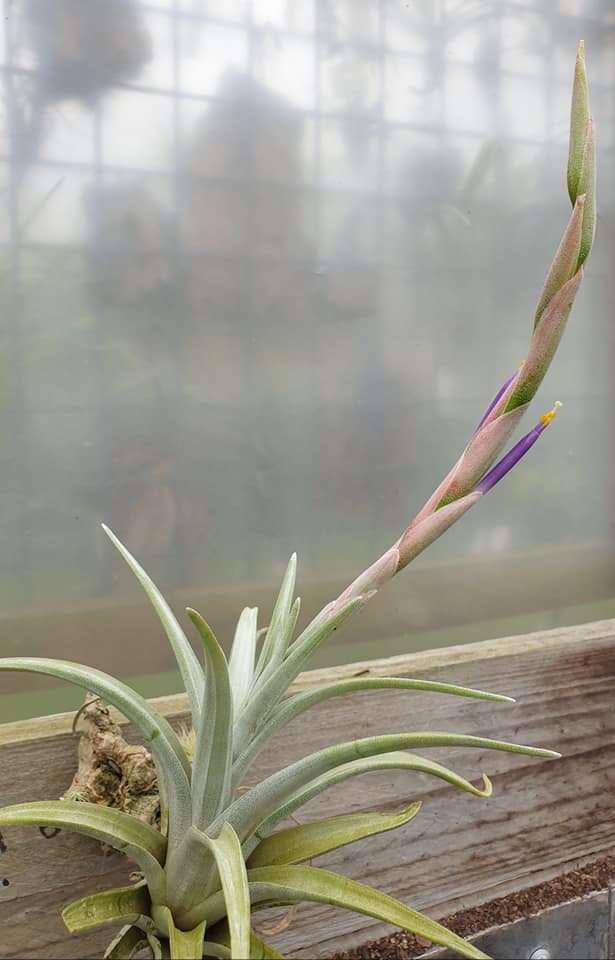
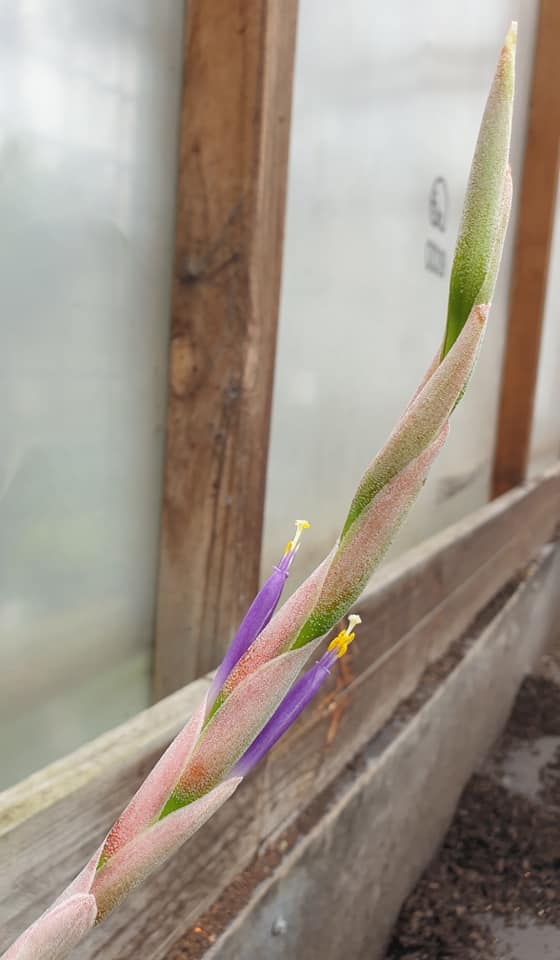
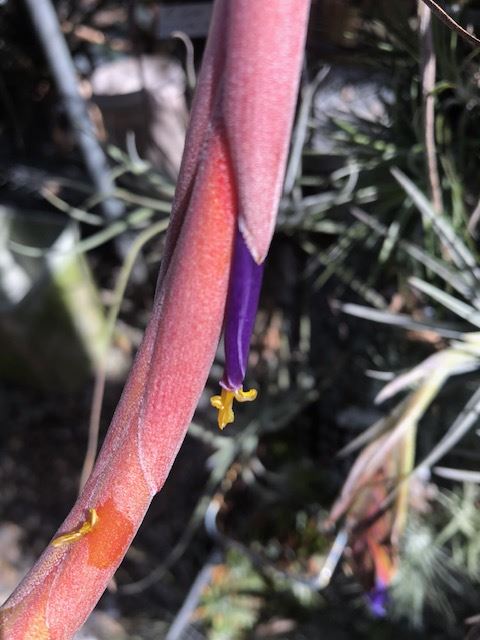

| Chris Larson 08/21. Quite a rare flowering for me. |
John Olsen 11/21 |
Tillandsia schatzlii W. Rauh ,Trop Subtrop Pflanz. 27: 426. 1979
Planta acaulis vel breviter caulescens; folia pauca rosulam erectam usque ad 25 cm altam, 10-12 cm diametientem formantia, basalia late triangulata elaminata; vaginae late ovales indistinctae, usque ad 4 cm longae, 3 cm latae, laete alutaceae, supra interdum dilute violaceae, sed plerumque laminis concolores, utrimque dense appresso-lepidotae; lamina modice succulenta, leviter involuta, anguste triangulata, attenuata, basi 2 cm lata, usque 20 cm longa, erecta vel apice recurvata, utrimque appresso-lepidota, squamae centro viridi; scapus inflorescentiae brevior quam folia, plus minusve 5 mm diametiens, erectus vel arcuatus; folia scapi subfoliata, superiora sine laminis, mori idaei colore, dense lepidota; inflorescentia pendula simplex usque ad 16 cm longa, 2 cm lata, 8-10 flora; bracteae florales mori idaei colore, basi lutescenti-virides, ecarinatae, imbricatae, coriaceae, usque ad 6cm longae, 2 cm latae, multo longiores quam calyx, supra disperse lepidotae, subtus dense appresso-lepidotae, trichomata margine fimbriata; flores sub anthesin cum stylo 2 cm exserto usque ad 8 cm longi, lucenti-caeruleo-violacei; sepala 2.7-2.9 cm longa acuminata, posteriora leviter carinata, viridia, dispersissime lepidota, plus minusve ad 3 mm connata; petala anguste ligulata margine revoluto, apice violacea, basim versus albida, intense violacea; antherae plus minusve 1 cm exsertae thecis luteis; stylus antherae plus minusve 1 cm superans pallide violaceus stigmatibus virescentibus.
Habitat: Mexico, ad rupes iuxta viam inter Oaxaca et Tehuacan.
Holotypus : BGH Nr. 46 304, Herbarium inst. bot. system. heidelbergensi (HEID).
Pflanze stammlos bis kurz stammbildend; Blatter zu wenigen, eine aufrechte, bis 25 cm hohe, 10-12 cm breite Rosette bildend (Abb. 3, oben); die basalen Rosettenblatter niederblattartig, breit-3-eckig, ohne Spreite; Scheiden breit-oval, undeutlich, bis 4 cm lang und 3 cm breit, hell leder-braunlich, oberseits zuweilen schwach violett, meist aber gleichfarbig mit der spreite und beiderseits dicht angedruckt beschuppt; Spreite schwach sukkulent, leicht involut, schmal 3-eckig, attenuat, an der Basis 2 cm breit, bis 20 cm lang, aufrecht oder an der Spitze zuruckgekrummt, beiderseits angedruckt beschuppt; Schuppen mit grunem zentrum; Infloreszenzschaft kurzer als die Blatter, ca. 5 mm dick, aufrecht bis bogig gekrummt; Hochblatter subfoliat, die oberen spreitenlos, himbeerrot, dicht lepidot; Inflorescenz hangend, einfach, abgerundet-schwertformig, bis 16 cm lang und 2 cm breit, 8-10-blutig; florale Brakteen himbeerrot, an der Basis gelblich_grun, ecarinat, imbricat, derb, bis 6 cm lang und 2 cm breit, vier langer als der Kelch, oberseits zerstreut beschuppt, unterseits dicht angedruckt lepidot (Abb. 3, unten); Trichome am Rande gefranst; Bluten z. z. der Anthese bis 8cm lang (einschlieBlich des 2 cm lang herausragenden Griffels; Abb. 3, unten), leuchtend blau-violett; Sepalen 2.7 - 2.9 cm lang, zugespitzt, die hinteren schwach gekielt, grun, sehr zerstreut lepidot, ca 3mm hoch verwachsen; Petalen schmal-zungenformig mit zuruckgerolltem Saum, an der Spitze violett, gegen die Basis weisslich; Filamente tiefviolett mit gelben Staubbeuteln; Staubblatter ca. 1 cm herausragend; Griffel die Staubblatter um 1 cm uberragend, blassviolett mit grunlichen Narben.
Heimat: Mexico (an Felsenwinden der Strasse zwischen Oaxaca und Tenuacan)
Holotypus: Herbarium des Instituts fur syst. Botanik der universitat Heidelberg. BGH No. 46 304.
Tillandsia schatzlii (Die Pflanze wurde nach St. Schatzl, Gartenoberinspektor des Botanischen Gartens der Universitat Linz, benannt. Schatzl hat als leidenschaftlicher Bromelienliebhaber mehrere Sammelreisen nach Mexico und Sudamerika unternommen) die erstmalig von Dr. Rutschmann in Zentral-Mexico entdeckt und dann von Schatzl an anderen orten des Staates Oaxaca wiedergefunden wurde - Verf. sah die pflanze auch in amerikanischen Sammlungen - gehort in den Verwandschaftskreis der vom Verf. beschriebenen, gleichfalls mexikanischen T. califani Rauh, doch ist diese viel grosser; sie bildet aufrechte, bis zu 40 cm hohe Trichterrosetten und aufrechte, bis zu 50 cm hohe, vielblutige Infloreszenzen. T. schatzlii aber ist in allen Teilen kleiner, besitzt auffallend sukkulente und zuweilen gebanderte Blatter, an denen sie leicht kenntlich ist, sowie nach abwarts gebogene Infloreszenzen.
Wuchsformenmassig bestehen auch Ahnlichkeiten zu der mexikanischen T. achyrostachys E. Morren; diese hat aufrechte Infloreszenzen und die Rosettenblatter sind von auffallend weicher Konsistenz, die floralen Brakteen sind kahl und die Bluten leuchtend grun.
Tillandsia schatzlii W. Rauh in J. Brom. Soc. 29(6): 260-1. 1979
Plant stemless (sometimes it has a rhizomatous stem) forms a small rosette of 25 cm in height and 12 cm in width;
Leaf sheaths are inconspicuous. broad-ovate. 4 cm long and 3 cm wide. light brownish to violet; the narrow triangulate. attenuate.
Leaf blades slightly succulent, brownish lepidote; sometimes they show crossbands.
Scape is shorter than the rosette, erect or curved;
Scape bracts at base subfoliate - the upper ones without blade and are of a raspberry-red color.
Inflorescence pendant, simple, up to 16 cm long and 2 cm wide, with 8-10 flowers;
Floral bracts densely lepidote, imbricate, ecarinate, up to 6 cm long and 2 cm wide, longer than the sepals, raspberry-red, green to the base.
Sepals 2.9 cm long, acute, the posterior ones slightly keeled, connate for 3 mm and green;
Petals narrow-ligulate, up to 8 cm long, dark-violet, white to the base, recurved at their tips;
Stamens with violet filaments and the long style is exserted.
The plant was found on steep rock walls between Oaxaca and Tehuacan. It is cultivated in the Heidelberg Botanical Garden under the number 46 304. Holotype HEID
Notes
For some years we have known of a small tillandsia that Dr. Rutschmann of Basel, Switzerland found in southern Mexico. Some time later the same plant was found by St. Schatzl of Vienna, Austria. who gave some plants to the Botanical Garden of Heidelberg. where they flowered. It is our opinion that this tillandsia is a new species belonging in the same group as T. achyrostachys E. Morren and T. califani Rauh, but it cannot be considered as a variety of either one of them. It is a separate species, which we have named after St. Schatzl, an enthusiastic bromeliad collector.
Updated 11/11/21






